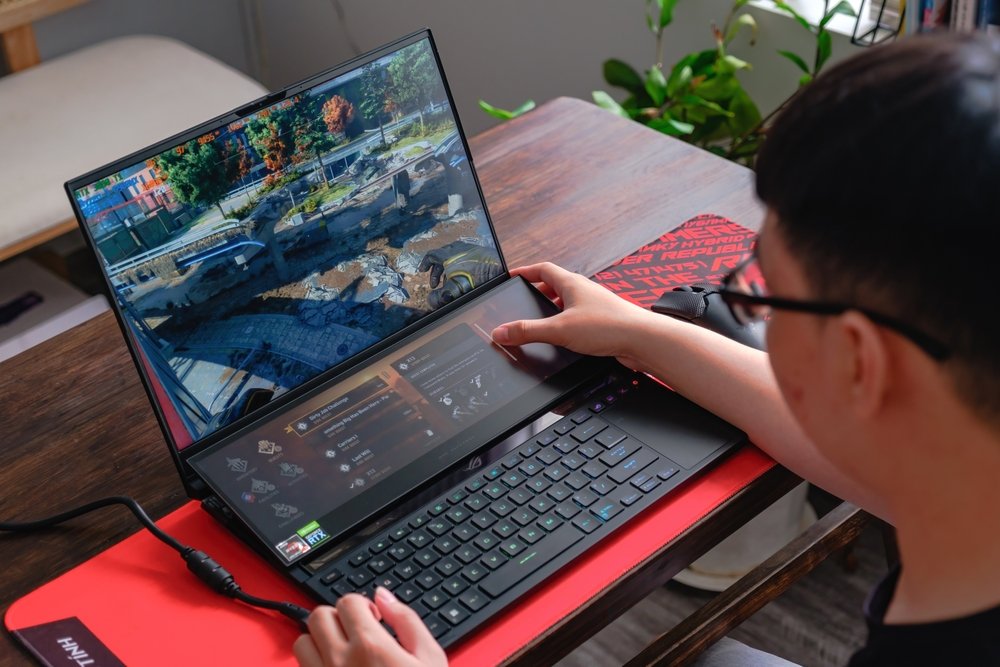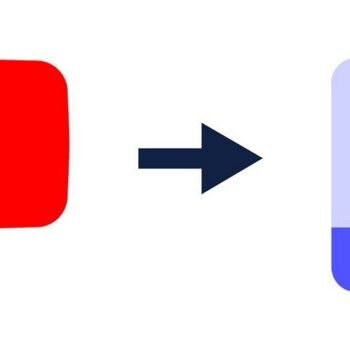TL;DR
Shopping for a gaming laptop in 2025 doesn’t have to be overwhelming. Here’s what matters most:
- GPU: RTX 50-series offers significant ray tracing improvements over previous generations
- RAM: 16GB DDR5 hits the sweet spot for most gamers; 32GB for content creators
- Display: 144Hz provides the best balance of smoothness and battery life for most users
- Budget: Expect to spend $1,200+ for solid RTX 50-series performance
Skip the marketing fluff. Focus on real-world benchmarks and your actual gaming needs.
Introduction
Every year, new buzzwords and flashy specs promise gaming heaven. But here’s the truth: marketing often highlights peak numbers that don’t match real playtime.
This gaming laptop buyer’s guide cuts past that noise. We’ll explain what counts when you’re battling opponents or exploring worlds. No corporate talk, no big promises – just practical tips to spend money smartly.
Gaming laptops changed a lot recently. Modern machines pack desktop power into portable frames. Yet, this performance means tradeoffs. You’ll face heat, shorter battery life, and higher prices. Understand these before buying.
GPU Deep Dive: The RTX 50-Series Revolution
What Sets RTX 50-Series Apart?

NVIDIA RTX 50 is a big step-up for mobile gaming graphics. Using newer tech, these chips offer clear gains in key spots:
- Better Ray Tracing: Roughly 40% faster than last-gen RTX 40 mobile GPUs
- DLSS 4.0: AI-boosted upscaling now creates extra frames for smoother action
- Power Smarts: More speed per watt means longer unplugged play and runs cooler
- AV1 Ready: Built-in support for modern streaming codecs
Ray tracing is finally ready for prime time on laptops. Older mobile GPUs often choked with it turned on. RTX 50 changes that completely.
RTX 50-Series vs. RTX 40/30-Series: Worth the Upgrade?
RTX 50-series laptops make a strong case for upgrading older hardware:
- RTX 30-Series Users: Expect big 60-80% gains in ray-traced titles
- RTX 40-Series Users: Smaller 20-30% bump, plus better power use
- Power Draw: Similar or lower consumption, even with more speed
- Memory: More VRAM across models tackles 4K gaming and content work
Skip moving up from RTX 40-series unless you really want specific RTX 50 features. But RTX 30-series users? The massive jump easily justifies your money.
Decoding GPU Naming Conventions
Understanding GPU tiers prevents expensive mistakes:
- RTX 5060: Entry-level 1080p gaming at high settings
- RTX 5070: Solid 1440p performance with ray tracing
- RTX 5080: High-end 1440p and entry-level 4K gaming
- RTX 5090: Flagship 4K gaming with maximum ray tracing
RTX 5070 vs. RTX 5080 represents the biggest price-to-performance jump. Most gamers find RTX 5070 sufficient for their needs, while RTX 5080 targets enthusiasts and content creators.
How Much GPU Power Do You Need?
Match your GPU to your display and gaming habits:
- 1080p Gaming: RTX 5060 handles everything at high settings
- 1440p Gaming: RTX 5070 provides excellent performance with ray tracing
- 4K Gaming: RTX 5080 minimum; RTX 5090 for maximum settings
- Competitive Gaming: Any RTX 50-series GPU paired with high refresh displays
Don’t overbuy GPU power if you’re gaming at 1080p. Invest saved money in better displays, more RAM, or premium build quality instead.
RAM Demystified: Beyond “Just Get 16GB”

Why RAM Matters for Gaming
- Game Loading: More RAM pulls assets faster from storage
- Background Apps: Discord, streams, and browsers eat up memory
- Future-Proofing: New games often need 16GB+ for best results
- Content Creation: Video work and streaming demand heavy RAM
Not enough RAM creates slowdowns even strong GPUs can’t fix. Watch for stuttering frames or long loads – those scream memory limits.
8GB, 16GB, 32GB, or 64GB? Future-Proofing Your Rig
Choose RAM capacity based on your usage patterns:
- 8GB: Insufficient for modern gaming; avoid unless budget-constrained
- 16GB: Sweet spot for most gamers; handles all current titles comfortably
- 32GB: Ideal for content creators, streamers, and heavy multitaskers
- 64GB: Overkill for gaming; only necessary for professional workloads
Most users benefit more from 16GB of fast RAM than 32GB of slower memory. Quality matters as much as quantity.
DDR5 vs. DDR4: Speed, Latency & Real-World Gains
DDR5 vs DDR4 RAM comparison reveals meaningful differences:
DDR5 Advantages:
- Higher bandwidth supports better integrated graphics performance
- Lower power consumption extends battery life
- Better overclocking headroom for enthusiasts
- Future compatibility with next-generation processors
DDR4 Considerations:
- Lower cost for budget builds
- Mature technology with proven stabilit
- Adequate performance for current games
DDR5 provides 10-15% better gaming performance in memory-sensitive scenarios. Choose DDR5 for new builds; DDR4 remains acceptable for budget systems.
Upgradability: Soldered vs. SODIMM Slots
RAM upgradability varies significantly between laptop models:
- Soldered RAM: Permanent installation; no upgrade path available
- SODIMM Slots: User-replaceable modules allow future upgrades
- Hybrid Design: One soldered module plus one upgradeable slot
- Dual SODIMM: Full upgradeability with two accessible slots
Gaming laptop RAM upgrade options influence long-term value. Prioritize laptops with at least one upgradeable slot for future flexibility.
Refresh Rates & Displays: Smoothness Wins Games

Refresh Rates Explained: 60Hz vs. 144Hz vs. 240Hz+
High refresh rate display technology transforms gaming experiences:
- 60Hz: Standard refresh rate; adequate for casual gaming
- 144Hz: Sweet spot for competitive gaming; noticeable smoothness improvement
- 240Hz: Diminishing returns; mainly benefits professional esports players
- 360Hz+: Extreme refresh rates with minimal real-world advantages
144Hz vs 240Hz comparison shows 144Hz provides the best balance of performance, battery life, and cost. Most gamers can’t perceive differences beyond 144Hz in typical gaming scenarios.
G-Sync vs. FreeSync: Taming Screen Tearing
Adaptive sync technologies eliminate visual artifacts:
G-Sync Features:
- NVIDIA proprietary technology
- Hardware-based implementation
- Premium pricing but guaranteed compatibility
- Superior low framerate performance
FreeSync Advantages:
- AMD open standard
- Lower cost implementation
- Wide industry adoption
- Compatible with NVIDIA GPUs (FreeSync Premium)
G-Sync vs. FreeSync choice depends on your GPU preference. Both technologies deliver similar results in real-world gaming scenarios.
Resolution vs. Refresh Rate: The Gamer’s Tradeoff
Balance resolution and refresh rate based on gaming preferences:
- 1080p/240Hz: Competitive gaming focus
- 1440p/144Hz: Balanced approach for most gamers
- 4K/60Hz: Visual quality priority
- 4K/120Hz: Premium option requiring powerful hardware
Higher resolutions demand more GPU power. Consider your hardware capabilities when choosing display specifications.
The Supporting Cast: Don’t Ignore These!
CPU Pairings: Intel 14th-Gen vs. Ryzen 8000
Modern CPUs rarely bottleneck gaming performance, but choose wisely:
- Intel 14th-Gen: Slight gaming performance edge; higher power consumption
- Ryzen 8000: Better multi-threaded performance; superior efficiency
- Core Count: 6-8 cores sufficient for gaming; 12+ cores benefit content creation
- Clock Speed: Higher boost clocks improve gaming performance
Both platforms offer excellent gaming performance. Choose based on specific laptop models and pricing rather than CPU brand loyalty.
Storage Secrets: NVMe SSD Speeds vs. Capacity
Gaming laptop SSD selection impacts loading times and system responsiveness:
- SATA SSD: Legacy interface; avoid in new laptops
- NVMe Gen 3: Adequate performance for most users
- NVMe Gen 4: Faster loading times; future-proofing benefit
- Capacity: 1TB minimum recommended; 2TB for extensive game libraries
Prioritize capacity over extreme speeds. Games benefit more from having adequate storage space than marginally faster transfer rates.
Thermal Design: Vapor Chambers vs. Heat Pipes
Thermal throttling ruins gaming performance regardless of hardware specifications:
- Heat Pipe Cooling: Traditional solution; adequate for mid-range hardware
- Vapor Chamber: Superior heat distribution; necessary for high-end GPUs
- Fan Design: Multiple fans improve cooling efficiency
- Thermal Paste: Quality thermal interface materials matter
Research thermal performance reviews before purchasing. Powerful hardware means nothing if thermal limitations prevent sustained performance.
Ports, Keyboard, and Build Quality
Don’t overlook practical considerations:
- Port Selection: USB-A, USB-C, HDMI, and Ethernet connectivity
- Keyboard Quality: Mechanical switches preferred for gaming
- Build Materials: Metal construction improves durability
- Weight: Consider portability needs versus performance requirements
Test keyboards in person when possible. Poor keyboard quality affects daily usage satisfaction more than minor spec differences.
Putting It All Together: Your Gaming Laptop Checklist
Budget Tiers: Best Picks Under $1k, $1.5k, $2K+
Budget gaming laptop recommendations by price range:
Under $1,000:
- RTX 4060/RTX 5060 with 16GB RAM
- 1080p/144Hz display
- Compromise on build quality and features
$1,500 Range:
- RTX 5070 with 16GB DDR5 RAM
- 1440p/144Hz IPS display
- Solid build quality and thermal design
$2,000+ Premium:
- RTX 5080/5090 with 32GB RAM
- 4K/120Hz or 1440p/240Hz displays
- Premium materials and advanced cooling
Best gaming laptop models balance performance, features, and value within each price tier.
Conclusion: Game On, Informed
Smart gaming laptop shopping means balancing power, features, and what you can spend. RTX 50-series GPUs bring big gains, great for ray tracing fans. But don’t overlook other parts that affect everyday satisfaction.
Focus on what games you really play, not just spec sheet promises. A balanced machine with good cooling beats poorly built high-end parts. Do your homework, try it out if you can, and buy from trusted sellers offering decent returns.
Gaming tech moves fast, but smart buying stays the same. Pick quality parts, effective cooling, and room to grow later over flashy marketing numbers.
FAQ: Your Burning Questions, Answered
How much RAM do I need for AAA games in 2025?
For 2025 AAA games, 16GB works as the baseline. Most new titles will list this for smooth play, though a few might want more for ultra settings.
32GB gives headroom. It’s great for future-proofing and handles heavy multitasking while gaming. Go for 32GB if you stream, edit content, or keep lots of apps open alongside your game.
Does a 240Hz refresh rate matter for casual gamers?
Honestly, 240Hz refresh offers small gains for casual gaming. Most folks won’t see a difference past 144Hz during regular play.
Competitive players might get a tiny edge in super-fast games. But for nearly everyone? 144Hz hits a better balance: smooth visuals, longer battery life, and easier cost.
Can I upgrade my laptop’s GPU later?
Modern laptops? They use soldered GPUs. You can’t swap them out later. That makes checking GPU benchmarks super important before buying – you’re locked into that power level.
Pick a GPU strong enough for what you’ll run over the next 3-4 years. Sure, plug-in graphics cards exist, but they add cost, hassle, and eat into that portability perk.





